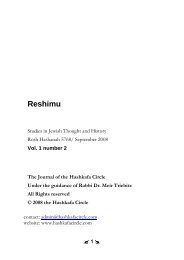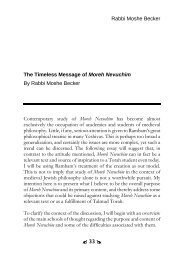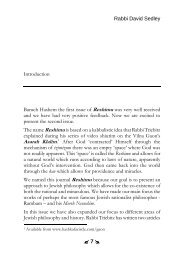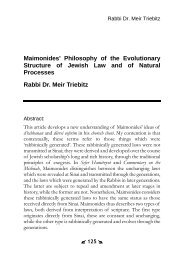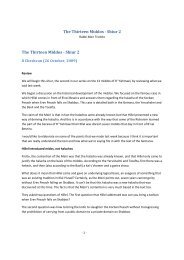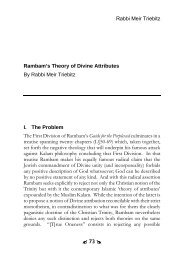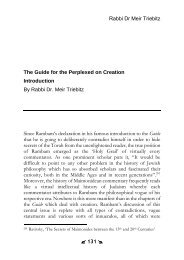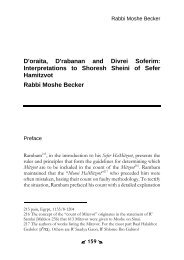Reshimu_3_journal_no.. - Hashkafa Circle
Reshimu_3_journal_no.. - Hashkafa Circle
Reshimu_3_journal_no.. - Hashkafa Circle
Create successful ePaper yourself
Turn your PDF publications into a flip-book with our unique Google optimized e-Paper software.
Rabbi Meir Triebitz<br />
The Rabbis teach: One who has in front of him several types of<br />
foods (on Shabbat) may select and eat, select and leave aside. He may<br />
<strong>no</strong>t select and if he does so he must bring a sin offering. [The<br />
Gemara asks] how should one read the baraita? Ullah says it should<br />
be read: One may select for that day, and put aside for that day. One<br />
may <strong>no</strong>t select, however, for the next day, and if one does so he must<br />
bring a sin offering. Rav Chisda raised an objection [to Ullah’s<br />
interpretation]. Is it permitted to bake for the same day? Is it<br />
permitted to cook for the same day? Rather, Rabba [interpreted the<br />
baraita differently and] said [this is how the baraita should be read]:<br />
One may select less than the amount [for which one brings a sin<br />
offering]. One may set aside for less than the amount [that one brings<br />
a sin offering]. One may <strong>no</strong>t, however, select an amount, and if he<br />
does so he must bring a sin offering.<br />
Rav Yosef raised an objection [to Rabba’s reading of the baraita]. Is it<br />
permitted to bake less than an amount? Is it permitted to cook less<br />
than an amount? Rather Rav Yosef reads the baraita in this following<br />
way... In his commentary to this Gemara, Ramban writes:<br />
“Rabba was <strong>no</strong>t originally coming to resolve Rav Chisda’s objection<br />
to Ullah’s reading of the baraita, but independently offered a reading<br />
of the baraita, without having heard Rav Chisda’s objection. Rather,<br />
Ullah and Rabba were making independent statements concerning<br />
the baraita and it is the [a<strong>no</strong>nymous redactor of the] ‘Gemara’ who<br />
placed their statements after the objections. This [phe<strong>no</strong>me<strong>no</strong>n]<br />
occurs in many places in the Talmud....”<br />
The Ramban is explicitly asserting here that the redactor of the<br />
Gemara constructed a give and take out of independent Amoraic<br />
statements, thereby creating the ‘sugya’ of the Gemara as it appears to<br />
us from the text of the Talmud as we k<strong>no</strong>w it. This method of<br />
construction was begun by Rav Ashi and, as we shall see, was<br />
continued in the several generations of Savoraim who came after<br />
him.<br />
43



